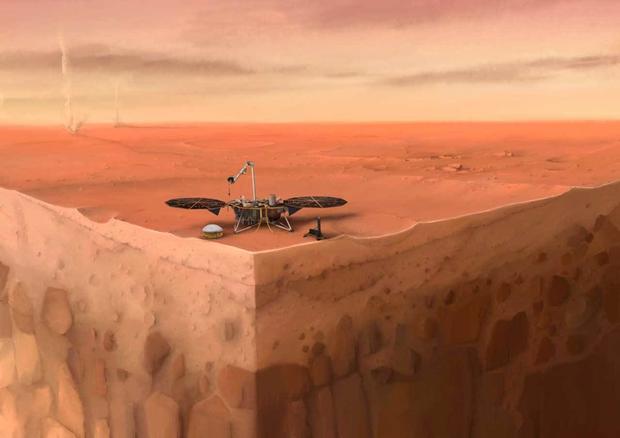NASA's InSight lander has detected over 450 "marsquakes" on the red planet
The first year of data from NASA's InSight lander is officially here, and it's revealing some surprising findings about Mars. The space agency announced Monday that hundreds of "marsquakes" have been detected on the red planet, providing potential insight into its inner workings.
InSight is the first mission specifically dedicated to uncovering the secrets beneath Mars' surface. It landed on the planet in November 2018 and detected its first quake in April; by the end of 2019, it was detecting around two seismic signals a day.
Among InSight's tools is a Seismic Experiment for Interior Structure (SEIS), which allows scientists to "hear" quakes even if they are thousands of miles from the lander. The trembles give scientists insight into the composition of Mars' inner structure, since seismic waves are affected by surrounding materials.
In a paper published in Nature Geoscience on Monday, scientists revealed that 174 marsquakes had been detected through last September, 24 of which were magnitude 3 to 4. But even the strongest of the quakes would not affect anyone on the surface of the planet, unlike strong quakes on Earth.
Since September, the amount of trembles recorded by SEIS since InSight landed has jumped to more than 450. It's more trembles than they expected to detect — but they were also milder than once thought.
Scientists said the vast majority of the trembles were likely marsquakes, rather than data noise created by wind or other environmental factors.
The largest quake was measured at magnitude 4.0, meaning it was not large enough to travel into the planet's lower mantle and core. The mantle and core are "the juiciest parts of the apple" when it comes to studying the inner structure of Mars, Bruce Banerdt, InSight principal investigator at NASA's Jet Propulsion Laboratory, said in a press release.
It's possible that larger quakes are occurring but have gone undetected. Scientists are still crossing their fingers that InSight will detect what they refer to as "the Big One."
Mars doesn't have tectonic planets like Earth does, so its quakes are produced through other processes, including volcanic activity, landslides and internal cooling. They are more intense than quakes on the moon but less intense than earthquakes, according to the paper.
"Knowledge of the level of seismic activity is crucial for investigating the interior structure and understanding Mars' thermal and chemical evolution," scientists wrote.
NASA scientists published a total of six studies Monday in the journals Nature Geoscience and Nature Communications, detailing InSight's first 10 months on the red planet. They have yet to draw a connection between the quakes, but said they hope that another year of data from InSight will uncover even deeper secrets about the red planet.






